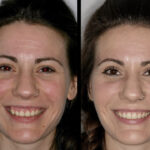INDICATIONS FOR USE
The invisalign System is indicated for the alignment of teeth during orthodontic treatment of malocclusion.
CONTRAINDICATION
The invisalign system is contraindicated for use in patients with the following condition: Active periodontal disease.
WARNINGS
- In rare instances, some patients may be allergic to the plastic aligner material.
- In rare instances patients with hereditary angioedema (HAE), a genetic disorder, may experience rapid local swelling of subcutaneous tissues including the larynx. HAE may be triggered by mild stimuli including dental procedures.
- In both cases, discontinue use and consult a health care professional immediately. Align Technology must also be notified.
- Orthodontic appliances, or parts thereof, may be accidently swallowed or aspirated and may be harmful.
PRECAUTIONS
- Keep aligners away from hot water and harsh chemicals.
- Keep aligners out of reach of young children and pets.
- Always store aligner in a cool, dry place.
- Treatment of severe open bite, severe overjet, mixed dentition, and/or skeletally narrow jaw may require supplemental treatment in addition to aligner treatment.
- Skeletal expanders, bonded auxiliaries, elastics, and other fixed and/or removable orthodontic appliances may be needed for more complicated treatment plans where aligners alone may not be adequate to achieve the desired outcome.
- Oral surgery may be necessary to correct severe crowding or jaw imbalances. If oral surgery is required, risks associated with anesthesia and proper healing must be taken into account prior to treatment.
- Atypically-shaped, erupting, and/or missing teeth may affect aligner adaptation and may affect the ability to achieve the desired results.
- Existing dental restorations (e.g., crowns, bridges) may become dislodged and require re-cementation or, in some instances, replacement.
- Aligners are not effective in the movement of dental implants.
- Certain medical conditions and use of certain medications may affect orthodontic treatment outcomes.
- Dental tenderness may be experienced following initial aligner placement and after switching to each new aligner in the series.
- The product may temporary affect speech and may result in a lisp, although any speech impediment associated with the product usually disappears within one or two weeks.
- Failure to wear the appliances for the prescribed number of hours per day and/or not using the product as directed by your doctor can lengthen the treatment time and affect the ability to achieve the desired results.
- Gums, cheeks, or lips may be scratched or irritated by the product.
- Attachments may be temporarily bonded to one or more teeth during the course of treatment to facilitate aligner retention and/or tooth movement.
- Attachments may fall off and require replacement.
- All attachments should be removed upon completion of treatment.
- Risks associated with interproximal reduction, which may be prescribed to create space for tooth movement as part of treatment must be taken into account.
- Tooth decay, periodontal disease, and permanent markings from stains and decalcifications may occur if patients do not brush and floss their teeth properly during treatment or if they consume foods or beverages containing sugar while wearing aligners.
- The bite may change throughout the course of treatment and may result in temporary patient discomfort.
- At the end of treatment, the bite may require adjustment by the doctor.
- Teeth may shift position after treatment. Consistent wearing of retainers at the end of treatment should reduce this tendency.
- It is recommended that all teeth should be at least partially covered to help prevent supra-eruption.
- Temporary increase in salivation or dryness of mouth may occur.
- A tooth that has been previously traumatized or significantly restores may be aggravated. In rare instances, the useful life of the tooth may be reduced, the tooth may require additional dental treatment such as endodontic and /or additional restorative work, and/or the tooth may be lost.
- The health of the bone and gums, which support the teeth, may be impaired or aggravated.
- The length of the roots of the teeth may be shortened during orthodontic treatment, which may become a threat to the longevity of the teeth.
- In rare instances, problems in the temporo-mandibular joint (jaw joint) may result in joint pain, headaches, or ear problems.
DAILY CARE AND MAINTENANCE OF INVISALIGN ALIGNERS
1. Cleaning recommendations:
Aligners should be cleaned prior to each insertion using a soft bristle toothbrush with water and a small amount of toothpaste.
Note: Be sure that each aligner is rinsed thoroughly with water after each cleaning. We also recommend that INVISALIGN aligner cleaning products are used once a week, or as needed.
2. Beware of damages:
Do NOT use denture cleaners to clean aligners. Do NOT soak them in mouthwash. These products can damage the surface of the aligner, causing it to become dull and more visible.
PROPER ORAL HYGIENE
1. Aligners should be removed for eating and drinking.
Patients do not need to remove aligners to drink cool water.
2. Patients should brush and floss their teeth after each meal or snack prior to re-inserting their aligners.
If they don´t have access to an Invisalign cleaning system or a tooth brush, they can simply rinse their mouth and then clean the aligners by holding them under warm running water.
It´s not the best way to clean, but it works in a pinch. Aligners should be thoroughly cleaned at the patient´s earliest convenience.



